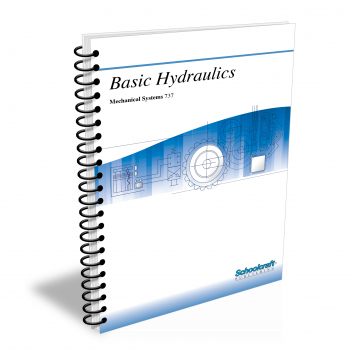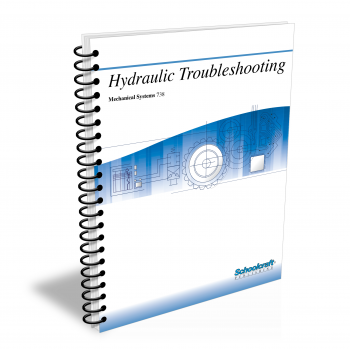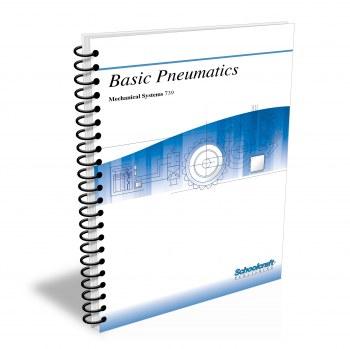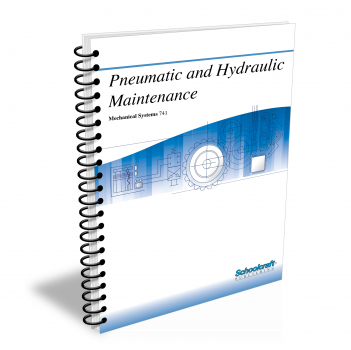Industrial Fluidpower
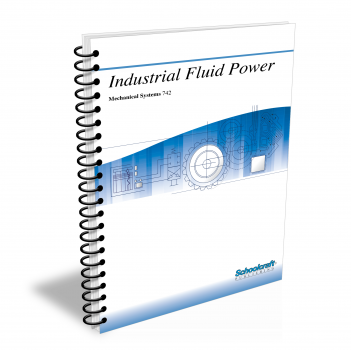
Course Number: 742
The Industrial Fluidpower textbook presents the fundamentals of fluid power. The first half examines the hydraulic principles associated with fluid power. It describes the various components that make up a complete system, how to read hydraulic drawings and diagrams, and how to maintain and troubleshoot the systems. The second half of the textbook explains the pneumatic principles of fluid power. Beginning with the relationships among pressure, force, work, and energy, the pneumatic chapters then go on to discuss the operation of reciprocating and rotary compressors. The textbook concludes with a discussion on how to troubleshoot major components of a pneumatic system.
Does your curriculum require additional topics not included in this textbook? Build a customized version of the Industrial Fluidpower textbook below.
Recommended Contact Hours – 33
Preview a Chapter
Available Supporting Material
- Table of Contents
- Exam Copies
- Suggested Titles
Table of Contents
Chapter 1: Principles of Hydraulics
Topics: Force, weight, mass, pressure, work, power, and energy; Incompressibility; Nondiffusion; Hydrostatic pressure; Pascal's Law; Fluid power transmission; Bernoulli's principle
Learning Objectives:
- Explain the difference between absolute and gauge pressure.
- Demonstrate how power is calculated.
- Explain Pascal's Law.
- Describe the difference between laminar and turbulent flow.
- Name the main components of a hydraulic system.
Chapter 2: Hydraulic Diagrams
Topics: Definition, kinds, and characteristics of schematics; Lines; Symbols; Flow patterns; Tracing a circuit; Sequence valve circuit
Learning Objectives:
- Name three basic types of hydraulic diagrams, and explain the purposes of each.
- Describe how a valve symbol is constructed.
- List the steps to follow when reading a schematic diagram.
- Identify common hydraulic symbols.
Chapter 3: Hydraulic Fluids
Topics: Viscosity; Pour point; Fluid selection; Chemical properties; System contamination; Dissolved air; Foaming; Corrosion and rusting
Learning Objectives:
- List the most important properties of hydraulic fluids.
- Explain how viscosity is measured.
- Explain the meaning of the viscosity index.
- Describe the effect of fluid temperature on viscosity.
- Name the causes of corrosion and fluid oxidation.
- Identify various types of hydraulic fluids.
Chapter 4: Strainers and Filters
Topics: Contaminant removal; Strainer performance; Types of strainers; Fibrous and nonfibrous filter media; Magnetic media; Installation
Learning Objectives:
- Name contaminants found in hydraulic systems.
- Explain the difference between a strainer and a filter, and describe the main function of each.
- Describe the two basic types of filter/strainer media.
- Draw graphic symbols for strainers and filters.
Chapter 5: Reservoirs and Accumulators
Topics: Reservoir, air separation requirements; Baffles; Reservoir cooling methods and accessories; Accumulators; Schematic symbols
Learning Objectives:
- Explain the functions of fluid reservoirs.
- Explain the purpose of reservoir baffles.
- Describe various methods of counteracting high operating temperatures.
- Identify important accessories used with reservoirs.
- Demonstrate pressure ratio calculation for a differential-piston accumulator.
Chapter 6: Hydraulic Pumps
Topics: Pump varieties, functions, and selection; Gear, screw, cycloidal, vane, axial-piston, and radial-piston pumps
Learning Objectives:
- Name the main classification of hydraulic pumps.
- List factors affecting pump selection and pump performance.
- Define volumetric efficiency and overall efficiency.
- Identify the most common types of positive-displacement pumps, and describe their operation.
Chapter 7: Hydraulic Directional-Control Valves
Topics: Valve classification; Automatic, two-way, check, pilot-operated, and spool valves; Hydraulic motors; NO, NC, holding valves; Symbols; Flow ratings
Learning Objectives:
- Explain the classification of directional control valves.
- Describe how manually operated valves work.
- Explain the difference between direct-acting and pilot-operated valves.
- Describe the operation of a check valve, a spool valve, a three-way valve, a four-way valve, and a rotary valve.
- Explain the difference between normally closed and normally open valves.
Chapter 8: Hydraulic Pressure-Control Valves
Topics: Poppet, spool, sequence, counterbalance, holding, unloading, and pressure-reducing valves; Shock suppressors; Flow-control valves
Learning Objectives:
- Explain the functions of a pressure-control valve, a pressure-relief valve, and a pressure-reducing valve.
- Describe the operation of a spool valve, a poppet valve, and a sequence valve.
- Explain the purpose of holding valves, unloading valves, and counterbalance valves.
- Name the operations performed by flow-control valves.
- Describe how pressure compensation and temperature compensation work.
Chapter 9: Hydraulic Cylinders
Topics: Double-, single-acting cylinders; Two-piston cylinders; Positional cylinders; Cylinder construction; Rings, seals, and packing; Cylinder mounting and selection; Flow capacity; Cushioning
Learning Objectives:
- Describe the purpose of a hydraulic cylinder, and explain how a double-acting cylinder works.
- Explain the difference between "pull-type" and "push-type" single-acting cylinders.
- Describe the construction of a hydraulic cylinder.
- Explain the various methods of mounting cylinders.
- Demonstrate how to calculate the flow capacity of a hydraulic cylinder.
Chapter 10: Hydraulic Motors
Topics: Performance specifications; Starting, running, and stalling torque; Volumetric efficiency; Hydraulic motor construction; Gear, vane, and piston motors
Learning Objectives:
- Explain the classification of hydraulic motors.
- Demonstrate how the torque of a hydraulic motor is calculated.
- Calculate the horsepower output of a hydraulic motor.
- Discuss cost factors and other considerations affecting motor selection.
- Describe the construction of a hydraulic motor.
- Explain the operating principles of a gear motor, a vane motor, and a piston motor.
Chapter 11: Maintaining Hydraulic Systems
Topics: Inspections; Maintenance requirements; Fluid level; External leaks; Operating pressure; Fluid quality; Filter maintenance; Reconditioning
Learning Objectives:
- List the major categories of hydraulic system maintenance.
- Name and describe the six essential items in a maintenance file.
- List the steps involved in reconditioning a hydraulic component.
- Explain how to set up a maintenance plan for a typical hydraulic system.
Chapter 12: Hydraulic System Troubleshooting
Topics: Diagnosis and symptoms; Evaluating machine history; Determining the cause; Providing the solution; Tools and gauges; Troubleshooting charts
Learning Objectives:
- Describe the troubleshooting process.
- Explain how to evaluate recent maintenance history.
- List typical symptoms of common hydraulic system problems.
- Explain how to determine the cause of and provide a solution to a problem.
- Explain how a portable tester works.
- Describe how to keep and use troubleshooting charts.
Chapter 13: Principles of Pneumatics
Topics: Fluid power systems; Force, weight, and mass; Pressure; Work and energy; Diffusion and dispersion; Compressibility; Laws of pneumatics; Leverage; Air properties and flow; Bernoulli's Law; Components
Learning Objectives:
- Explain how force is transmitted in a pneumatic system.
- Calculate force and work.
- List two factors that affect the results of pressure calculations.
- Explain pneumatic leverage.
- Briefly explain the physical laws affecting the behavior of a confined gas.
Chapter 14: Pneumatic Diagrams
Topics: Schematic symbol construction; Diagramming an air supply; Simple pneumatic systems; Timing and safety circuits; System schematics
Learning Objectives:
- Explain the different types of symbols used in pneumatic schematic diagrams-how they are constructed and what they show.
- Describe the operation of timing and safety circuits.
- Analyze the schematic diagram of a fluid-power system.
Chapter 15: Reciprocating Compressors
Topics: Compressor construction, classification, and operation; Single-, double-acting compressors; Cooling requirements; Lubrication; Controls
Learning Objectives:
- Differentiate between a positive-displacement compressor and a dynamic compressor.
- Describe the operation of a reciprocating compressor.
- List one advantage of using a multistage compressor.
- Identify the cooling arrangements for reciprocating compressors.
- Compare the operation of compressor controls in large and small units.
Chapter 16: Rotary Compressors
Topics: Vane, rotary-screw, low-pressure, high-volume, diaphragm, centrifugal, and axial-flow compressors; Compressor capacity; Accessories
Learning Objectives:
- Compare the power output of a single-stage vs a two-stage vane compressor.
- Describe the main types of positive-displacement rotary air compressors.
- Explain the advantages and disadvantages of both types of dynamic compressors.
- Describe four methods of controlling centrifugal compressor output.
- Tell how to compensate for a low-speed drive in rotary screw compressors.
Chapter 17: Pneumatic Directional-Control Valves
Topics: Manually and automatically operated valves; Control valve elements: spools, poppets, disks, and plates; Two-, three-, four-, and five-way valves; Accessories
Learning Objectives:
- Describe the four methods of identifying control valves.
- List four basic types of manually operated, two-way valves.
- Describe the operation of a two-position, direct acting, normally closed solenoid valve.
- Explain one major advantage of using a four-way valve.
- Describe the construction of a three-way valve.
Chapter 18: Pneumatic Pressure-Control Valves
Topics: Safety vs relief valves; Relief valve construction; Pressure regulators; Pilot-operated, remote-controlled regulators; Logic functions
Learning Objectives:
- List two ways a valve can control compressor pressure output.
- Describe construction of two basic types of pressure-relief valves.
- Contrast a pressure regulator with a pressure-relief valve.
- State the limit imposed by Federal Law on the pressure allowed when an air hose is used to blow off chips.
Chapter 19: Pneumatic Cylinders
Topics: Double-, single-acting cylinders; Two-piston cylinders; Cylinder construction, mounting, and selection; Performance charts; Cushioning
Learning Objectives:
- Tell the difference between pneumatic and hydraulic cylinders.
- Describe the construction and operation of a single-acting cylinder.
- State the purpose of an exhaust flow control metering valve.
- Describe the action of a pivoted cylinder.
- Explain the size relationship between a cylinder port and a valve port.
Chapter 20: Pneumatic Motors
Topics: Motor rating; Selection factors: pressure, speed, torque, horsepower, reliability, and service life; Rotary vane and piston motors; Air boosters
Learning Objectives:
- Explain pneumatic motor classification.
- Define torque.
- Describe pneumatic motor construction.
- Calculate a motor's horsepower, given its torque and speed.
- Differentiate between a pneumatic motor and a rotary actuator.
Chapter 21: Pneumatic System Maintenance
Topics: Control system maintenance; Cylinder maintenance; Tool maintenance; Logs and records; Automatic recorders and recording charts
Learning Objectives:
- Explain the concept of planned maintenance.
- Describe the basic procedures for maintaining the compressor and other important components in a pneumatic system.
- Describe the maintenance of industrial control circuit components.
- Explain the proper maintenance of pneumatic tools.
- Discuss the various types of maintenance logs and explain what kind of information is recorded in each.
Chapter 22: Pneumatic System Troubleshooting
Topics: Locating troubles; Operations manual; Checking the air supply; Troubleshooting valves and actuators; Interlocks; Final adjustments
Learning Objectives:
- List, in proper sequence, the steps to be taken in troubleshooting a pneumatic system.
- Name and describe the five important parts of every pneumatic system's operations manual.
- Describe procedures for troubleshooting the actuator.
- Explain how to check control valves, sequence valves, and interlocks.
Request Exam Copies
Exam Copies
Ready to see a copy of our textbooks? After selecting which textbooks you’d like to review for your course, you can submit your request by either logging in or creating an account so we know where to ship your exam copies. A representative from Schoolcraft will contact you to confirm and finish processing your request.
Exam copies are always free and yours to keep.
Selected Exam Copies
none selected
* Maximum of five copies can be ordered
